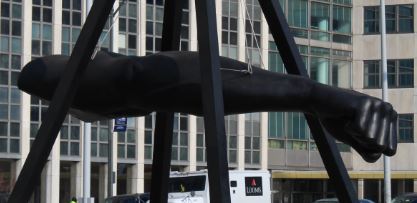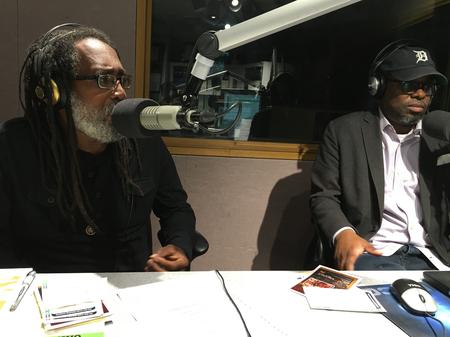Before 1967, Black Nationalism Was Taking Root in Detroit
Nkenge Zola examines the movement in this archived report from 1997.

Editor’s note: Nkenge Zola produced this report for WDET. It aired in 1997.
When Detroit police raided an after-hours night club at 12th and Clairmount on July 23, 1967, a riot broke out. Over the next several days, 43 people would die in the violence. Historian Thomas Sugrue wrote a book in 1996, in which he described a deep and seething anger growing in Detroit’s black community more than a decade before the rebellion. That sentiment was sometimes reflected in songs such as “Sam’s Life” by Oscar Brown, Jr.
“There’s a fellow I know / Folks call him Sam / He never gets as much as he gives / But if you give a listen please sir please ma’am / I’ll tell you something ‘bout how / Sam lived”
Brown’s song could be a biography of any of the thousands of black men who, decades before, had transplanted themselves from exhausted lands in the American South to plantations of the North: factories. Not everyone, however, felt like “Sam”. Louis X — now Minister Louis Farrakhan — recorded “White Man’s Heaven is a Black Man’s Hell” during the same period.
“Before we came to America / We were living in the East, by the Nile River / We were living in luxury / In joy, freedom, justice, and equality / We wore silken robes, slippers of gold / We were the wealthiest and the wisest people.”
Whereas Oscar Brown’s character, Sam, was accepting, resigned to the work the hand he’s dealt, Louis X’s narrator wants something different. These recordings document in song a change in the sentiment and the attitude of black Americans, especially in Detroit. Politically, the shift was expressed by two visionaries: Dr. Martin Luther King, Jr. and Malcolm X.
“I’ve been trying to think about what I’m going to preach about tomorrow down at Central Methodist Church on the Lenten series. And I think I’ll use the text, ‘Father forgive them, for they know not what they do.'” — Dr. Martin Luther King, Jr.
“There was two kind of slaves.There was the house Negro and the field Negro. The house Negro – they lived in the house. With Master. They dressed pretty good. They ate good, ‘cause they ate his food – what he left.” — Malcolm X.
King Solomon Baptist Church on Detroit’s west side is where Malcolm X gave his famous “Message to the Grass Roots” in 1963. It countered established civil rights leaders like King, who, that same year, led a freedom walk of 100,000 people down Woodward Avenue. Chicagoan Bob Lucas had ties to many Detroit-area activists.
“When we started out in the late ’50s and the early ’60s, we thought this was a country of morals, and people had respected morality,” Lucas says. “We felt that all we had to do was have some meetings and have some rallies and make some placards and pass out some leaflets and then, and show America that she was wrong. And she would just give us our freedom just like that. Well, that’s really because we were naive.”
The debate over segregation versus desegregation was playing out on television sets, newspapers, and in radio reports. The “Negro Question” became public and personal. And while the dogs were biting and hoses were trained on peaceful marchers; while some were beaten or killed for their effort to — as poet Langston Hughes wrote, “Let America Be America”; others were beginning to reject the strategy, tactics, and premise of the nonviolence movement for racial integration. That movement was led principally by the Southern Christian Leadership Conference and the National Association for the Advancement of Colored People. For many blacks, though, the civil rights movement no longer hit the mark.

“The Black Power movement, to me, meant basically to give people a sense of pride,” says Dr. James Jackson of Muskegon. “It was never one to give people a sense of what they could do to empower themselves.”
Jackson and attorney Milton Henry were candidates for governor and lt. governor for the Michigan Freedom Now party. While the quest for electoral power was important, Jackson says it conflicted with a drive for self-identification embodied in the Black Power movement, and it created confusion.
“All that kind of confusion just led for continued errors, like burning, not realizing the kind of struggle we were in, accepting the kind of jobs that forced us to do the things we were complaining about, like mayors, police chiefs, and everything else,” Jackson says. “All they did is change the color and not the structure. But in order for us to change the structure, we had to know how to get power, and that philosophical approach never became a reality.”
As the Michigan Freedom Now party ran candidates, the seeds of Black Christian nationalism were being sown by Rev. Albert Cleage in his church on Linwood in Detroit. Not many blocks away, there was constant activity at the Nation of Islam’s Temple No. 1, founded by the Hon. Elijah Muhammad in the 1930s. Leftists were organizing workers and students. Through years of readings, study, talking, and organizing, this melange of activists and thinkers was able to articulate demands for addressing police brutality, inequality in the auto plants, and the destruction of strong, economically viable parts of black communities such as Black Bottom and Paradise Valley. Both were razed when Interstate 75 was built.
READ MORE: CuriosiD: How a 1900s Black Detroit Community Was Razed For a Freeway
In Detroit, NAACP members created the innovative and highly successful Sip-In for Freedom Club, a variation on the movement’s Pray-Ins and Wait-Ins. Supporters would pay for sipping wine or champagne to raise money for the association’s activities. More radical ideas and actions were alive, too.
Malik Yakini co-founded the Detroit Black Community Food Security Network, and was executive director of Nsoroma Institute, an African-centered elementary school. He recalls first tasting political power as a student at Post Junior High School.

“I guess I was a young man,” Yakini says. “I guess I was a young man. We were looking for very strong images, and very radical, militant images, and the civil rights movement didn’t provide that for myself or those who were around me. So that’s one reason we gravitated more towards revolutionary politics, more towards nationalist and pan-Africanist thinking. I was just much more attracted to the strength and the dynamism that I saw within these kind of ‘new Jack’ leaders at that time.”
Some of the “New Jacks” of the day were Communist Party member Angela Davis, who, with her signature Afro, was “on the lam”, and Huey Newton, the Black Panther Party leader photographed on a wicker throne, spear in one hand, rifle in the other. But even before the photos were shot and enlarged, descendants of the enslaved wrestled with what to call themselves. “Colored” – or “Negro” with a capital “N” – perhaps, “Black”?
In post-’67 Detroit, new words and ideas became common, such as “self-determination” and “Black Power.” Police became “pigs.” African clothing became fashionable. Defense funds were formed to free Davis, Newton, and the “Chicago Seven“. Muslim names, natural hair, watermelon-flavored pop, Afros, cornrows, and bean pies; all came into vogue along with the philosophies of Karl Marx, Friedrich Engels, Mao Zedong, and Stokely Carmichael. To those who embraced these changes, the problems were not just caused by an individual but by “the establishment” – the system, co-optation, pacification, conspiracy theories, and “do your thing.”
